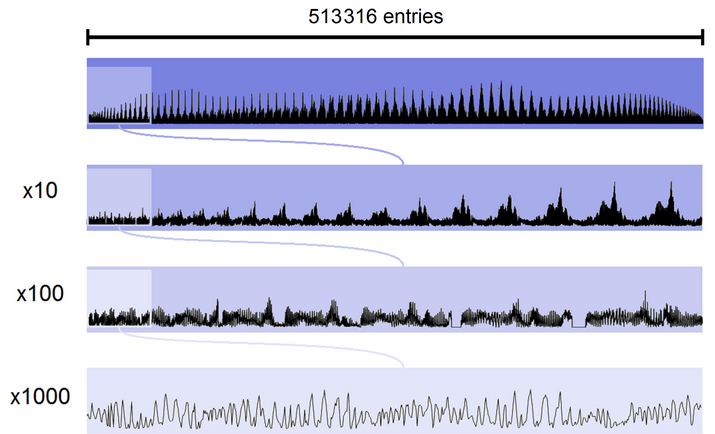New unique brain ‘fingerprint’ method can identify a person with nearly 100% accuracy
November 18, 2016

A research team led by Carnegie Mellon University used diffusion MRI to measure the local connectome of 699 brains from five data sets. The local connectome comprises the point-by-point connections along all of the white matter pathways in the brain, as opposed to the connections between brain regions. To create a fingerprint, they used diffusion MRI data to calculate the distribution of water diffusion along the cerebral white matter’s fibers. (credit: Carnegie Mellon University)
Researchers have “fingerprinted” the white matter of the human brain using a new diffusion MRI method, mapping the brain’s connections (the connectome) at a more detailed level than ever before. They confirmed that structural connections in the brain are unique to each individual person and the connections were able to identify a person with nearly 100% accuracy.
The new method could provide biomarkers to help researchers determine how factors such as disease, the environment, genetic and social factors, and different experiences impact the brain and change over time.
“This means that many of your life experiences are somehow reflected in the connectivity of your brain,” said Timothy Verstynen, an assistant professor of psychology at Carnegie Mellon University and senior author of the study, published in open-access PLOS Computational Biology.
The local connectome: a personal biomarker

Demonstrating the level of detail, one local connectome fingerprint is shown in different zoom-in resolutions. A local connectome fingerprint has a total of 513,316 entries of scalar values. (credit: Fang-Cheng Yeh et al./PLoS Comput Biol)
For the study, the researchers used diffusion MRI to measure the local connectome of 699 brains from five data sets. The local connectome is the point-by-point connections along all of the white matter pathways in the brain, as opposed to the connections between brain regions. To create a fingerprint for each person, they used the diffusion MRI data to calculate the distribution of water diffusion along the cerebral white matter’s fibers.*
The measurements revealed the local connectome is highly unique to an individual and can be used as a personal biomarker for human identity. To test the uniqueness, the team ran more than 17,000 identification tests. With nearly 100 percent accuracy, they were able to tell whether two local connectomes, or brain “fingerprints,” came from the same person or not.
Curiously, they discovered that identical twins only share about 12 percent of structural connectivity patterns and the brain’s unique local connectome is sculpted over time, changing at an average rate of 13 percent every 100 days.
Decoding unexplored connectome data
“The most exciting part is that we can apply this new method to existing data and reveal new information that is already sitting there unexplored. The higher specificity allows us to reliably study how genetic and environmental factors shape the human brain over time, thereby opening a gate to understand how the human brain functions or dysfunctions,” said Fang-Cheng (Frank) Yeh, the study’s first author and now an assistant professor of neurological surgery at the University of Pittsburgh.
So we can start to look at how shared experiences — for example, poverty, or people who have the same pathological disease — are reflected in their brain connections, which could lead to new medical biomarkers for certain health concerns.
The team included researchers at the U.S. Army Research Laboratory, the University of Pittsburgh, the National Taiwan University, and the University of California, Santa Barbara. The Army Research Laboratory funded this research, which was supported by NSF BIGDATA, WU-Minn Consortium, the Ruentex Group, the Ministry of Economic Affairs, Taiwan, and National Institutes of Health.
* The local connectome is defined as the degree of connectivity between adjacent voxels within a white matter fascicle measured by the density of the diffusing water. A collection of these density measurements provides a high-dimensional feature vector that can describe the unique configuration of the structural connectome within an individual, providing a novel approach for comparing differences and similarities between individuals as pairwise distances. To evaluate the performance of this approach, the researchers used four independently collected diffusion MRI datasets with repeat scans at different time intervals (ranging from the same day to a year) to examine whether local connectome fingerprints can reliably distinguish the difference between within-subject and between-subject scans.
Abstract of Quantifying Differences and Similarities in Whole-Brain White Matter Architecture Using Local Connectome Fingerprints
Quantifying differences or similarities in connectomes has been a challenge due to the immense complexity of global brain networks. Here we introduce a noninvasive method that uses diffusion MRI to characterize whole-brain white matter architecture as a single local connectome fingerprint that allows for a direct comparison between structural connectomes. In four independently acquired data sets with repeated scans (total N = 213), we show that the local connectome fingerprint is highly specific to an individual, allowing for an accurate self-versus-others classification that achieved 100% accuracy across 17,398 identification tests. The estimated classification error was approximately one thousand times smaller than fingerprints derived from diffusivity-based measures or region-to-region connectivity patterns for repeat scans acquired within 3 months. The local connectome fingerprint also revealed neuroplasticity within an individual reflected as a decreasing trend in self-similarity across time, whereas this change was not observed in the diffusivity measures. Moreover, the local connectome fingerprint can be used as a phenotypic marker, revealing 12.51% similarity between monozygotic twins, 5.14% between dizygotic twins, and 4.51% between none-twin siblings, relative to differences between unrelated subjects. This novel approach opens a new door for probing the influence of pathological, genetic, social, or environmental factors on the unique configuration of the human connectome.